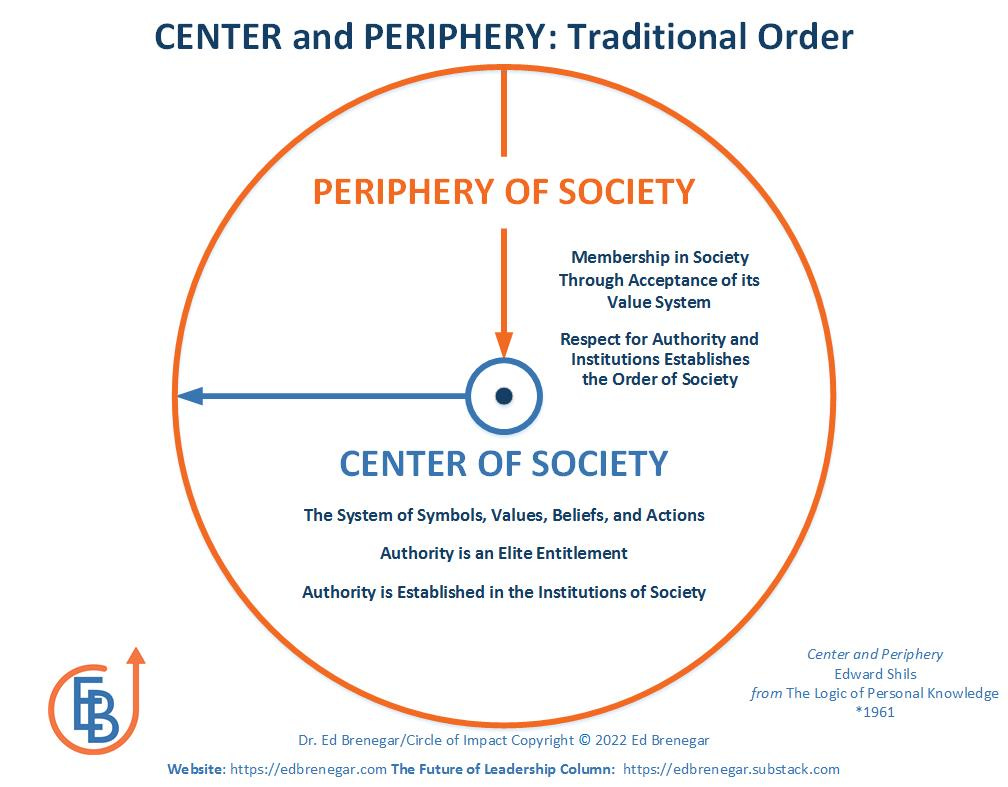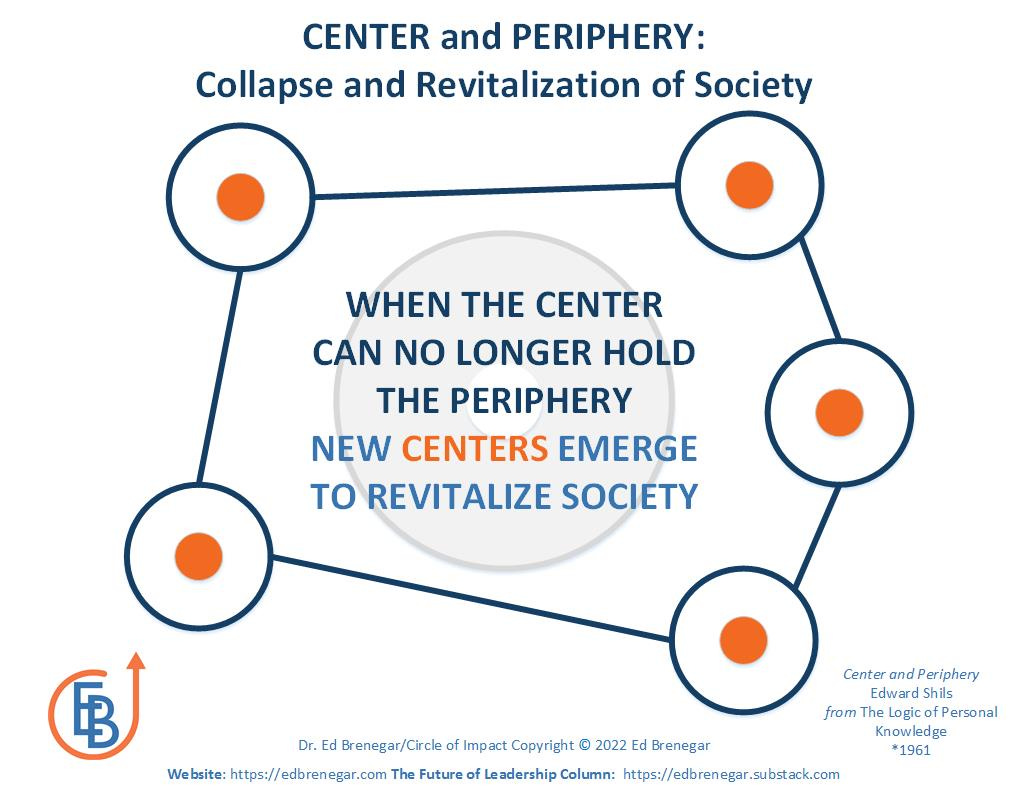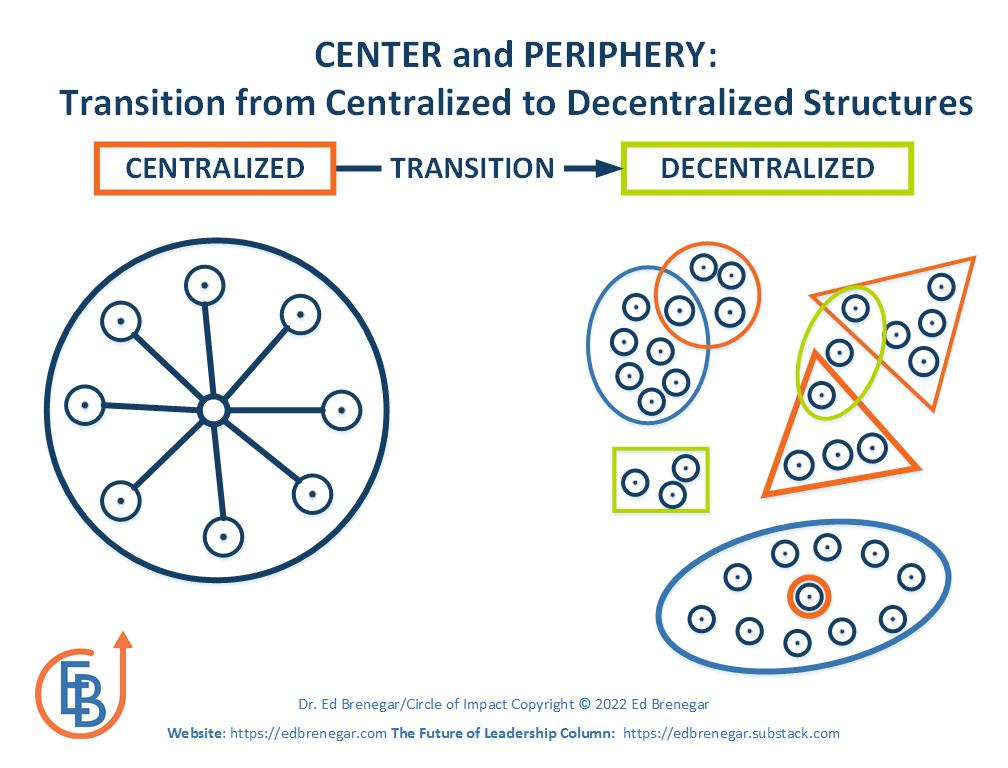As The Center Does Not Hold, the Periphery Grows
Understanding What Happens and Why When Society Begins to Fragment
Society as the Context for Leadership
We tend to think of society as this mix of groups, institutions, and political and social ideologies. Modern society has become a mix of competing beliefs claiming to define the whole of society. Instead, society is divided, fragmented, and ordered increasingly around our individual preferences.
From Compartmentalized to Integrated to Marginalized
When I was in undergrad school in the 1970s, my academic program American Studies sought a broad scope for a possible understanding of American culture. There really is no name for this kind of holistic, integrated view of a culture. We were pushing against the tide of the compartmentalized fields of knowledge. The trend marginalized intellectual pursuit into ever more narrow subjects. It produced the result of the expert who knows a lot about very little.
In my mind, I wanted to integrate every discipline into a holistic picture of our time. It is still my method of operation. The program back then fed my curiosity as it still does today.
Fifty years later, that same program has lost its breadth of context. Every faculty member and every Ph.D. student focuses on research that is minimalist and self-referential. I am sure they would disagree. But it is what I saw at a departmental reunion a few years ago as we were presented with their current research work. I offered this observation to the retired faculty who were my teachers, who in many respects made me the inquirer that I am. They responded with silence. What else could they say?
My take-away from this experience was that the more miniaturized our self-perception becomes the more marginalized we become. Whatever field of endeavor we choose to make as our defining ambition in life is still marginalized by the lack of an integrating culture of shared values that society used to have.
Today, there is no unified whole to society except the government or shall we call it the State. One of the presidential candidates in 2020 said, “Government is what we do together.” Are we all now agents of the State? Some politicians would like this kind of control over society. It means that society has now been transformed into an authoritarian structure of control. I will say more about this in my next column. Now I want to focus on society as a whole.
Center and Periphery
We have not been a whole society during the past century except when a crisis calls us to join together. The last time we experienced unity as a society was in the aftermath of the 9/11 attacks. President Bush stepped forward in the first hours and days and called the nation to be unified against terrorism. Even that moment of national unity was short-lived. Our national unity was fractured as the nation through the political parties realized as we went to war in Iraq and Afghanistan that they were going to lose their leverage for taking advantage of the threat of terrorism. Even a global pandemic was not enough to unify society. Instead, it did more to divide us from one another
Society is a fluid reality that moves between integration and disintegration all the time. It is a cyclical process. So, as we are dividing into smaller and smaller enclaves of ideological passion, the point will come when we can divide no further. Society will not go away, but reform itself.
Sixty years ago, Edward Shils wrote an essay called Center and Periphery that described the integrated social fabric of society.
“Society has a center. There is a central zone in the structure of society. This central zone impinges in various ways on those who live within the ecological domain in which the society exists. Membership in the society … is constituted by relationship to this central zone.
The central zone is not, as such, a spatially located phenomenon. … The center, or the central zone, is a phenomenon of the realm of values and beliefs. It is the center of the order of symbols, of values and beliefs, which govern society. It is the center because it is the ultimate and irreducible; and it is felt by many who cannot give explicit articulation to its irreducibility. The central zone partakes of the nature of the sacred. In this sense, every society has an ‘official’ religion … The center is also a phenomenon of the realm of action. It is a structure of activities, of roles and persons, within the network of institutions. It is in these roles that the values and beliefs which are central are embodied and propounded.”
This is how societies form and function. Even primitive societies function this way. Pierre Clastres describes these as societies against the state. They organize around the values that define society. Leadership in primitive societies has a different role than what we see in modern Western states. Borrowing from Robert Lowie, Clastres describes the chief of the primitive tribe as needing three skills. The chief serves as a peacemaker. The chief is generous in securing wealth to distribute to the tribe. And the chief is a good orator speaking daily to the tribe to remind them who they are and the values that define their society. The principal distinction between primitive and modern leadership is that the primitive chief has no power or authority over the tribe. The tribe makes decisions as a whole.
Miguel Abensour describes Clastres view of a society with a state.
“For there to be power, the society must be divided on the basis of a commanding-obedience relationship. Society must be divided into the top – the dominant – and the bottom – the dominated, who obey. A power that is not exerted is not power. Power is brought to bear by the fact that those on top force those on the bottom to pay a tribute … Clastres professes a restrictive view of power in that it is specifically political and in that power relationship takes the form of division. Once the political division exists there is an obligation to pay one’s debt to the chief … “But what’s the use of the tribute? First of all, it is a marker of power, it’s the sign of power! … The tribute is the sign of power and at the same time it’s means for maintaining it, the means of ensuring the permanency of the sphere of power…”
In other words, there is political power that divides and social power that can unify based on shared values. This is the picture that I see having taken place over the past half-century. Political power has grown while the social power of shared values has diminished. The result is a growing gap between the center and the periphery, between those who lead and those who are meant to follow.
Let me illustrate this transition with the following diagrams.
Seeing the Center and Periphery
I draw diagrams to help me visualize complex ideas. I have reproduced my drawings to help us better understand the complex nature of the Center and the Periphery.
This picture of society as a center and periphery is one of integration and wholeness. The center is like a magnet drawing the periphery into a more connected relationship. In modern society, the Center consists principally of the institutions of the State collaborating with large technology and media companies, global corporations, and other societal institutions. At the Center resides the power to dictate how society is ordered and functions.
The Periphery consists of people, families, local institutions, and the personal relationships that we have with people. The power that resides here is relational, not institutional. As a result, the periphery is subject to the power of the center.
The integration of the Center and the Periphery is a product of the recognition of the symbols, values, beliefs, and actions that define society. In this sense, the Center is the structure of a belief system that unites the Center and the Periphery. The Periphery, as a result, grants respect to those in authority in the Center. They do so because they share common beliefs about society.
The US Constitution and the Declaration of Independence are documents that constitute the system of symbols, values, and beliefs of American society. To believe and act in accordance with these beliefs integrates the Center and the Periphery to form the union that provides security and prosperity for citizens.
In Edward Shils scenario, the Center is the controlling force of society. The progress of the Center dictates the progress of the Periphery. If the Center abandons the belief system of society in favor of more subsidiary or contrary beliefs, the Periphery will begin to abandon respect for the Center.
This fragmentation of society through its institutions is what I have observed throughout my work in the field of leadership. When the values of an organization or a society become compromised, discarded, or contrary to its historic culture, the society does not reunify but breaks apart into smaller sub-societies.
When the Center cannot hold the Periphery, it either dissolves or becomes authoritarian. It means that the Periphery is now marginalized and exists to be exploited for that which serves the interests of the Center. The integration of the Center and the Periphery is gone, and a fragmented, divided society results.
When the Center no longer supports the Periphery, the Periphery must turn to its own resources. As a result, multiple smaller Centers form. These new Centers learn to exist more independently of the traditional Center. The phenomenon that is taking place we call Decentralization.
In a Centralized society, the movement is Centripetal, towards the center. Drawing attention and energy from the Periphery into the Center.
In a society that is becoming more Decentralized, the movement is Centrifugal, as new Centers seek to establish new Peripheries.
We are witnessing the breakup of modern society. The Center cannot hold without becoming authoritarian. The history of control-centric societies is that they ultimately fail. Think of it like a chokehold on society.
The authoritative center of global society is fragmenting as it seeks to consolidate and concentrate power at the Center. Yet, the Center has for many decades become less and less integrated meaningfully in the life of the Periphery. The Periphery is increasingly having to create its own security and prosperity. As a result, we are moving away from a society of institutions to one that is more relational, and centered in the life of local communities. As a result, power becomes less concentrated and more distributed out to the Periphery and beyond. This is not just an American phenomenon. It is a global one.
The Beauty of the Center and the Periphery
I think of society like a sunflower. The nourishment and reproductive function of the flower are in the center. Yet the beauty of the flower is in its petals. It is what attracts the insect population to come and help to pollinate flowers for new growth. In this sense, the center cannot exist without the beauty of the petals and the interaction with the insects. Today, the flower of the State is dying. It fails to understand that it only can exist in a healthy, shared existence with the Periphery.
When a portion of the Periphery finds itself exiled from the Center, it does not remain the Periphery, but creates its own Center and Periphery. This is how societies rejuvenate.
The Two Global Forces
I am convinced that we are in a transition that I have talked about as the Two Global Forces. There is the global force of centralized institutions of governance and finance and the global force of decentralized networks of relationships. The interplay between these two forces will determine what our global world will look like for the next century.
In my next column, I will define my perspective on globalization through the lens of the centralization-decentralization structure.








Fascinating. Center and Periphery - very helpful framing. Love the sunflower example too.
"The interplay between these two forces will determine what our global world will look like for the next century."
Yes. de-centralized must win out in the end, which if I'm understanding this as intended, does not exclude the center and periphery model being incorporated in these smaller decentralized groups?
I'll have to reread to better integrate. Thank you.